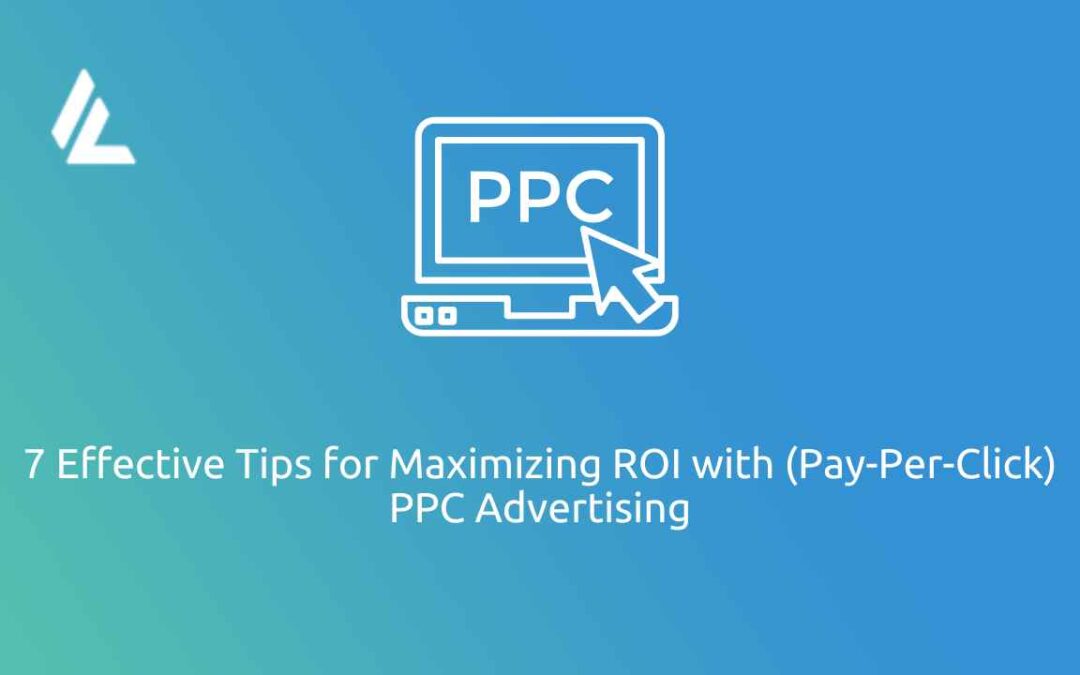Table of Contents
Pay-Per-Click – PPC advertising is a powerful tool for driving targeted traffic to your website and generating leads. However, to make the most of your PPC campaigns, it’s essential to optimize your strategy and maximize your return on investment (ROI). In this blog post, we’ll discuss seven effective tips for maximizing ROI with PPC advertising. Whether you’re new to PPC or looking to improve your existing campaigns, these tips will help you achieve better results.
1. Define Clear Campaign Goals :
Defining clear campaign goals is the first step to maximizing ROI with PPC advertising. With specific objectives, it’s easier to measure success accurately and make informed optimizations. Determine what you want to achieve through your PPC campaigns, such as increasing sales, generating leads, or boosting brand awareness. By setting clear goals, you can align your campaign strategy and focus on the metrics that matter most to your business.
Once you have your campaign goals in place, break them down into measurable key performance indicators (KPIs). For example, if your goal is to increase sales, your KPIs could be the number of conversions, the average order value, or the return on ad spend (ROAS). By defining these KPIs, you’ll be able to track your progress and make data-driven decisions to improve your ROI.
2. Conduct Thorough Keyword Research :
Keyword research is a critical aspect of PPC advertising. It helps you identify the keywords and phrases your target audience is using when searching for products or services similar to yours. Conducting thorough keyword research allows you to uncover high-volume, low-competition keywords that can drive qualified traffic to your website.
Start by brainstorming a list of relevant keywords that are closely related to your business. Then, use keyword research tools like Google Keyword Planner, SEMrush, or Moz to expand your list and gather insights on search volume, competition, and keyword variations. Look for keywords that have a good balance between search volume and competition, as they present an opportunity to reach your target audience effectively.
When selecting keywords for your PPC campaigns, consider the intent behind the search. Are users looking for information, comparing products, or ready to make a purchase? By aligning your keywords with the user’s intent, you can deliver more relevant ads and increase your chances of conversions.
Additionally, focus on long-tail keywords, which are more specific and have lower competition. Long-tail keywords can attract highly targeted traffic and often result in higher conversion rates. Incorporate these keywords into your ad copy, ad groups, and landing pages to improve the relevance and quality of your campaigns.
3. Craft Compelling Ad Copy :
Compelling ad copy is essential for capturing the attention of your target audience and driving them to click on your ads. When creating your ad copy, keep the following tips in mind:
- Highlight Unique Selling Propositions (USPs): Communicate what sets your products or services apart from the competition. Identify the unique benefits or features that make your offering valuable to your target audience.
- Use Clear Calls-to-Action (CTAs): Encourage users to take the desired action by including a strong and clear call-to-action in your ad copy. Whether it’s “Buy Now,” “Sign Up Today,” or “Learn More,” a compelling CTA motivates users to click on your ad and move forward in the conversion funnel.
- Be Concise and Relevant: Due to limited ad space, it’s crucial to convey your message concisely and focus on the most important information. Use attention-grabbing headlines and compelling descriptions that align with the user’s search intent.
- Test Multiple Variations: Don’t settle for a single ad copy. Instead, create multiple variations and conduct A/B testing to identify the most effective messaging. Test different headlines, descriptions, CTAs, and even display URLs to determine which combinations drive the highest click-through rates (CTR) and conversions.
4. Optimize Landing Pages:
Your PPC campaigns can drive significant traffic to your website, but to maximize ROI, you need to ensure that your landing pages are optimized for conversions. Here are some key considerations:
- Alignment with Ad Copy: Your landing pages should provide a seamless experience for users who click on your ads. Ensure that the content, messaging, and design of your landing pages align with the corresponding ad copy. Consistency reassures users that they’ve landed on the right page and increases the likelihood of conversion.
- Clear and Compelling Headlines: Use persuasive headlines that grab attention and communicate the value proposition of your offering. Your headline should immediately convey what users can expect from your product or service.
- Engaging and Relevant Content: Provide informative and engaging content that addresses the user’s needs and pain points. Clearly explain how your product or service can solve their problems or fulfill their desires. Use bullet points, visuals, and customer testimonials to enhance the readability and credibility of your content.
- Strong Call-to-Action: Like in your ad copy, your landing pages should include a strong and visible call-to-action. Make it clear what action you want users to take, whether it’s making a purchase, filling out a form, or contacting your business.
- Mobile Optimization: With the increasing use of mobile devices, it’s crucial to optimize your landing pages for mobile users. Ensure that your pages load quickly, have a responsive design, and offer a seamless experience across different screen sizes.
By following these tips, you can create landing pages that encourage users to take the desired action, resulting in higher conversion rates and improved ROI.

5. Implement Ad Extensions :
Ad extensions are additional pieces of information that can be added to your PPC ads, providing more context and increasing their visibility. By utilizing ad extensions, you can enhance the performance and effectiveness of your ads. Here are a few ad extensions to consider:
- Sitelink Extensions: These allow you to add additional links to different pages of your website. Sitelinks provide users with more options to explore your website, increasing the chances of them finding what they’re looking for.
- Call Extensions: If your business relies on phone calls, implementing call extensions enables users to call your business directly from the ad. This is particularly effective for mobile users who prefer to connect with businesses via phone.
- Location Extensions: If you have a physical store or office, location extensions can display your business address and a map alongside your ad. This makes it easier for potential customers to find your physical location.
- Review Extensions: Adding review extensions lets you showcase positive reviews and ratings from reputable sources. This social proof can instil trust and confidence in users, making them more likely to click on your ad.
- Callout Extensions: Callout extensions allow you to highlight specific features or benefits of your products or services. Use this extension to emphasize key selling points and capture users’ attention.
By implementing relevant ad extensions, you can make your ads more informative, engaging, and appealing to users, resulting in higher click-through rates and improved ROI.
6. Continuously Monitor and Optimize:
Successful PPC campaigns require ongoing monitoring and optimization. Set aside time regularly to review the performance of your campaigns and make data-driven decisions to improve your ROI. Here are some key areas to focus on:
- Performance Metrics: Analyze key performance metrics such as click-through rates (CTR), conversion rates, cost per acquisition (CPA), and return on ad spend (ROAS). Identify trends and patterns to understand which campaigns, keywords, or ads are performing well and which ones need improvement.
- Negative Keywords: Continuously review your search terms report to identify irrelevant or low-performing keywords. Add these keywords as negative keywords to prevent your ads from showing irrelevant search queries. This helps to optimize your budget and improve the quality of your traffic.
- Ad Copy and Design: Test different ad variations to determine which ones perform best. Make incremental changes to headlines, descriptions, and visuals to refine your messaging and design. Continuously experiment and optimize to improve CTR and conversion rates.
- Landing Page Optimization: Monitor the performance of your landing pages and conduct A/B testing to identify elements that can be improved. Test different layouts, content, and calls to action to increase engagement and conversions.
- Budget Allocation: Assess the distribution of your budget across campaigns and keywords. Allocate more budget to top-performing campaigns and keywords while reducing or pausing underperforming ones. This allows you to maximize your investment in high-performing areas.
7. Utilize Remarketing :
Remarketing is a powerful technique that allows you to target users who have previously visited your website but didn’t convert. By showing tailored ads to these users as they browse other websites or platforms, you can encourage them to return and complete the desired action. Here are some strategies to effectively utilize remarketing:
- Segment Your Audiences: Divide your remarketing audiences based on their behavior and interaction with your website. For example, create segments for users who abandoned their shopping carts, visited specific product pages, or engaged with certain content. This segmentation allows you to deliver more personalized and relevant ads.
- Create Compelling Ads: Craft remarketing ads that remind users of their previous interactions with your website and highlight relevant products or offers. Use persuasive copy and visuals to re-engage users and entice them to return.
- Offer Incentives: Consider offering incentives to encourage users to convert. This could include exclusive discounts, free trials, or limited-time offers. By providing additional value, you can motivate users to take action and improve your chances of converting them.
- Frequency Capping: Be mindful of how often you show remarketing ads to users. Setting frequency caps ensures that your ads don’t become intrusive or annoying. Strike a balance between staying visible and avoiding ad fatigue.
- Dynamic Remarketing: Utilize dynamic remarketing to display ads that showcase the specific products or services users previously viewed on your website. This personalized approach can significantly increase engagement and conversions.
- Cross-Channel Remarketing: Extend your remarketing efforts beyond just display ads. Utilize other channels such as social media platforms or email marketing to reach out to your remarketing audiences. This reinforces your brand presence and increases the likelihood of conversion.
- Test and Optimize: Continuously test different ad variations, audiences, and strategies to optimize your remarketing campaigns. Analyze the performance metrics and adjust your approach based on the data. Experiment with different messaging, visuals, and offers to find what resonates best with your audience.
Conclusion:
Maximizing ROI with PPC advertising requires careful planning, ongoing monitoring, and optimization. By defining clear campaign goals, conducting thorough keyword research, crafting compelling ad copy, optimizing landing pages, implementing ad extensions, continuously monitoring and optimizing, and utilizing remarketing, you can improve the effectiveness of your PPC campaigns and achieve higher ROI. Remember to analyze the data, adapt to changing trends, and keep testing and refining your strategies to stay ahead in the competitive PPC landscape. With these tips, you’ll be well on your way to driving better results with your PPC advertising efforts.

